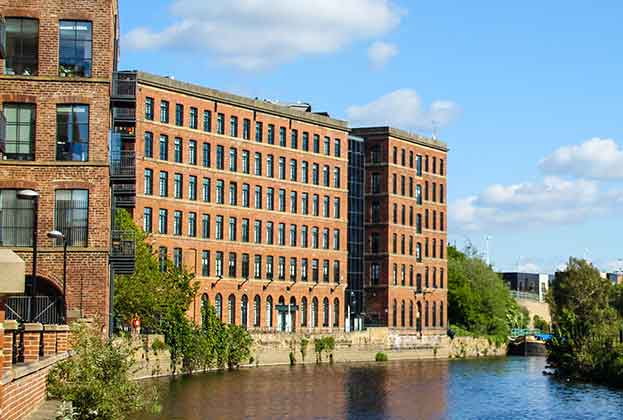Attracting and retaining the best talent is central to creating innovation. What is attracting and keeping this talent in Leeds?
Attracting talent
Leeds has the potential to attract key employers and occupiers, but it will need to provide the right product in the form of new prime buildings if it is to compete with the “Big 6” regional cities. Currently, Leeds still offers one of the lowest rents among the large regional cities, with overall operating costs 30% lower than London and the South East. These currently include 9 Wellington Place (176,000 sq ft), the next phase of MEPC’s award-winning development in the city centre, as well as the significant and exciting commitment by Vastint to develop Aire Park, a new mixed-use district on the South Bank of the River Aire. The next office building at Aire Park will comprise 75,000 sq ft and is due for completion in early 2025, while 1 and 3 South Brook Street (140,000 sq ft) are due for completion at the end of this year.
The significant confidence in take-up is undoubtedly supporting developer activity across Leeds. When complete, this influx of new buildings will provide a much-needed boost to the supply of Grade A space within the city, driving rents upwards and attracting key employers with an opportunity to acquire standout office space.
Retaining talent
A skilled workforce is fundamental for attracting employers and investment to the city. Leeds has a diverse workforce in terms of skills, comparable with the national average. But Leeds is also home to five universities which attracts a diverse talent pool.
A key priority for the city is not only to attract high-value talent but also to retain this talent for the long term. Leeds does successfully retain graduate talent. The city currently retains the fifth highest number of graduates, ahead of Bristol, Cambridge and Oxford, but it falls behind other growing cities such as Manchester, Birmingham and Glasgow. Of the 55,600 students that graduate from the universities across Leeds each year, 27%, equivalent to 12,500 students, are retained in the city post-graduation.
Graduates employed in Leeds are most likely to work in human health and social work (17%) and education (17%). But the city also retains a graduate talent pool in key growth sectors. 33% of graduates in Leeds work in science and technology-related fields, in line with the national average. These high-value, research-intensive sectors offer higher median graduate salaries of c.£20,968 compared to median graduate incomes of £17,976 in Leeds.
Leeds loses more graduates than it retains. Each year over 13,750 graduates leave the city. 18% of students in Leeds moved to London and a further 6% moved to Manchester
Lydia McLaren, Associate Director, Residential Research
Leeds does, however, lose more graduates than it retains. Each year over 13,750 graduates leave the city. 18% of students in Leeds moved to London after their studies, and a further 6% moved to Manchester, with many graduates frequently enjoying higher incomes in the science and technology sectors. Leeds has a prime opportunity to improve graduate retention and hold on to more of the high-value talent it creates, following the likes of Manchester, Birmingham and Glasgow.
Housing is affordable
Despite graduates earning lower median salaries than the national average, a fundamental driver for talent moving to Leeds is the relative affordability of the housing market and lower cost of living pressures. With a median house price to income ratio of 6.8 in 2022 compared to a national figure of 8.2 and 13.3 in London, Leeds is well placed to attract and retain a skilled workforce.
In comparison to other cities where an unaffordable housing market drives talent away, the barrier to entry to the housing market in Leeds is relatively low and graduates can afford to access both the private rental market and the sales market.
We have modelled the affordability of the rental market in Leeds in comparison to other cities. Two graduates together on two median salaries, assuming a 30% spend of gross income on rent, can afford to rent 50% of two-bed listings in Leeds in the 12 months to Q1 2023, rising to 82% for two graduates on upper quartile salaries. The rental market in Leeds is much more affordable and accessible to graduates than both Manchester and London, the two biggest cities that Leeds loses graduates to.
Alongside an affordable rental market, graduates can also afford to buy in Leeds. Modelling the affordability of buying reveals that two graduates on median salaries purchasing a home at 4x loan-to-income and at an 80% loan-to-value could afford 32% of the total housing market in Leeds, rising to 52% for two graduates on upper quartile salaries. This is comparable to Manchester and marginally below Birmingham but is significantly ahead of London.
Fundamentally, the affordability of the housing market in Leeds is a huge pull factor, but the city needs to retain talent for the long term. Leeds should be providing a diverse range of housing to accommodate different household groups, from high-quality purpose-built student or Build to Rent stock in the city centre to larger family housing in the outer suburbs.
For more information, please contact Simon Lister or Matthew Jones at our Leeds Office
Read the articles within Spotlight: Leeds – creating and delivering innovation below.
.jpg)
